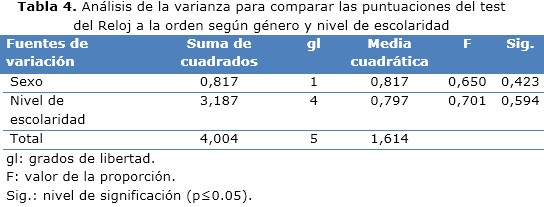Clock Drawing test, version of Cacho and García to order, in healthy elderly
Abstract
Background: one of the most widely used instruments in the medical literature for evaluating cognitive functions in older adults is the Clock Drawing test.
Objective: to evaluate the normative values of the Clock Drawing test, version of Cacho and García, in healthy elderly who attend grandparents' homes.
Methods: a descriptive study was carried out from the quantitative approach. The universe was made up of 84 older adults who attend grandparents' homes in the Holguín municipality, in the period between May 2019 and March 2020. 60 older adults were selected through a probabilistic sampling. Socio-demographic, cognitive functioning and the normative values of the Clock Drawing test were considered as variables. The semi-structured interview, the Mini-examination of the mental state, the Katz index, the Lawton scale and the Clock Drawing test were used. The results were processed with the EPIDAT 3.1 and MedCal packages.
Results: the age range of the older adults was 61-93 years. There was the same percentage value for the female and male sex. Primary education level predominated. The elderly obtained in the Clock test a minimum score of 6.5 and a maximum of 10. The average value reached was 9.21.
Conclusions: the minimum scores achieved by the elderly are within the normative values of the qualification of the clock test, for cognitively healthy elderly.
DeCS: POPULATION DYNAMICS; AGED; ALZHEIMER DISEASE; GERIATRICS; MENTAL STATUS AND DEMENTIA TESTS.
Downloads
References
1. Oficina Nacional de Estadística e Información. Centro de Estudios de Población y Desarrollo. Anuario demográfico de Cuba 2018 [Internet]. La Habana: ONEI; Jun 2019 [citado 15 Jul 2020]. Disponible en: http://www.onei.gob.cu/sites/default/files/anuario_demografico_2018_0.pdf
2. Romero AJ. Mirando la vejez a través del cristal sociológico. Geriatrianet.com [Internet]. 2006 [citado 15 Jul 2020];8(1):13. Disponible en: http://www.geriatrianet.com
3. Sousa RM, Ferri CP, Acosta D, Albanese E, Guerra M, Huang Y, et al. Contribution of chronic disease to disability in elderly people in countries with low and middle incomes: a 10/66 Dementia Research Group population-based survey. Lancet [Internet]. 2009 Nov [citado 15 Jul 2020];374(9704):[aprox. 10 p.]. Disponible en: https://www.ncbi.nlm.nih.gov/pmc/articles/PMC2854331/.
4. Espín Falcón JC. Factores de riesgo asociados a pacientes con enfermedad de Alzheimer y sus cuidadores principales. Rev cuban med gen integr [Internet]. 2020 [citado 15 Jul 2020];36(1). Disponible en: http://www.revmgi.sld.cu/index.php/mgi/article/view/1138
5. López-Álvarez J, Agüera-Ortiz L. Nuevos criterios diagnósticos de la demencia y la enfermedad de Alzheimer: una visión desde la psicogeriatría. Psicogeriatría [Internet]. 2015 [citado 15 Jul 2020];5(1):[aprox. 12 p.]. Disponible en: https://www.viguera.com/sepg/pdf/revista/0501/501_0003_0014.pdf
6. Corona Miranda B, Prado Rodríguez R, Duany Navarro A. Epidemiologia de las demencias. Arch hosp Calixto García [Internet]. 2020 [citado 03 Feb 2021];8(2). Disponible en: http://revcalixto.sld.cu/index.php/ahcg/article/view/514/442
7. Aschiero MB, González MJ, Grasso L. Influencia de variables sociodemográficas en el réndimiento de la Frontal Assessment Battery en adultos mayores argentinos. Rev Iberoamericana de Psicología [Internet]. 2019 [citado 15 Jul 2020];12(2):115-124. Disponible en: https://reviberopsicologia.ibero.edu.co/article/view/157
8. González Aguilar MJ, Rubio M, Grasso L. Evaluación del potencial de aprendizaje en adultos mayores: influencia de la mediación en una prueba de memoria. Cienc Psicol [Internet]. Nov 2018 [citado 15 Jul 2020];12(2). Disponible en: http://www.scielo.edu.uy/scielo.php?script=sci_arttext&pid=S1688-42212018000200215
9. Luna Lario P, Azcárate Jiménez L, Seijas Gómez R, Tirapu Ustarroz J. Propuesta de una batería neuropsicológica de evaluación cognitiva para detectar y discriminar deterioro cognitivo leve y demencias. Rev Neurol [Internet]. 2015 [citado 15 Jul 2020];60(12):[aprox. 9 p.]. Disponible en: https://medes.com/publication/99952
10. Cacho Gutiérrez J, García García R, Arcaya Navarro J, Gay Puente J, Guerrero AL, Gómez Sánchez JC, et al. El test del reloj en ancianos sanos. Rev Neurol. 1996;24: 1525-1528.
11. Carnero Pardo C, Rego García I, Barrios López JM, Blanco Madera S, Calle Calle R, López Alcalde S, et al. Evaluación de la utilidad diagnóstica y validez discriminativa del Test del Reloj y del Mini-Cog en la detección de deterioro cognitivo. Neurol [Internet]. 2019 [citado 15 Jul 2020]. Disponible en: https://www.sciencedirect.com/science/article/pii/S0213485319300088 DOI: 10.1016/j.nrl.2018.12.002
12. Oscanoa T. Evaluación de la prueba del reloj en el tamizaje de enfermedad de Alzheimer. An Fac med [Internet]. Mar 2004 [citado 15 Jul 2020];65(1). Disponible en: http://www.scielo.org.pe/scielo.php?script=sci_arttext&pid=S1025-55832004000100007
13. Cacho J, García García R, Arcaya J, Vicente JL, Lantada N. Una propuesta de aplicación y puntuación del test del reloj en la enfermedad de Alzheimer. Rev Neurol [Internet]. 1999 [citado 15 Jul 2020];28(7):[aprox. 8 p.]. Disponible en: http://neurologia.publicacionmedica.com/contenido/images/Una_propuesta_de_aplicaci%C3%B3n_y_puntuaci%C3%B3n_del_test_del.pdf
14. Duro D, Freitas S, Tábuas Pereira M, Santiago B, Botelho MA, Santana I. Discriminative capacity and construct validity of the Clock Drawing Test in Mild Cognitive Impairment and Alzheimer’s disease. The Clinical neuropsychologist [Internet]. 2018 Nov [citado 15 Jul 2020];33(7). Disponible en: https://novaresearch.unl.pt/en/publications/discriminative-capacity-and-construct-validity-of-the-clock-drawi DOI: 10.1080/13854046.2018.1532022
15. Pinto E, Peters R. Literature review of the clock drawing test as a tool for cognitive screening. Dementia and Geriatric Cognitive Disorders [Internet]. 2009 [citado 15 Jul 2020]; [27(3): [aprox. 13 p.]. Disponible en: https://pubmed.ncbi.nlm.nih.gov/19225234/.
16. Tan LP, Herrmann N, Mainland BJ, Shulman K. Can clock drawing differentiate Alzheimer’s disease from other dementias? Int Psychogeriatr [Internet]. 2015 Oct [citado 15 Jul 2020];27(10):[aprox. 11 p.]. Disponible en: https://pubmed.ncbi.nlm.nih.gov/26138809/.
17. López N, Allegri R, Soto Añari M. Capacidad diagnóstica y validación preliminar del test del Reloj, versión de Cacho a la orden, para Enfermedad de Alzheimer de grado leve en Población Chilena. Rev Ecuat Neurol [Internet]. 2014 [citado 15 Jul 2020];23(1-3):[aprox. 6 p.]. Disponible en: http://revecuatneurol.com/wp-content/uploads/2016/01/Capacidad-Diagno%CC%81stica-y-Validacio%CC%81n-Preliminar-del-Test-del-Reloj_REN-Vol-23-N%C2%BA1-3-2014-2.pdf
18. American Psychiatric Association. Guía de consulta de los criterios diagnósticos del DSM 5. Madrid: Medica Panamericana; 2014.
19. Aprahamian I, Martinelli JE, Liberalesso Neri A, Sánchez Yassuda M. The accuracy of the Clock Drawing Test compared to that of standard screening tests for Alzheimer's disease: results from a study of Brazilian elderly with heterogeneous educational backgrounds. Int Psychogeriatr [Internet]. 2010 Feb [citado 15 Jul 2020];22(1):[aprox. 8 p.]. Disponible en: https://pubmed.ncbi.nlm.nih.gov/19814841/.
20. Lozada D, Castro EL, Vera IC, Iglesias MF, Lebron MR, Torti SS. Empleo del test del Reloj en el telemonitoreo de pacientes en un hospital público. X Congreso Internacional de Investigación y Práctica Profesional en Psicología XXV Jornadas de Investigación XIV Encuentro de Investigadores en Psicología del MERCOSUR [Internet]. Buenos Aires: Universidad de Buenos Aires; 2018 [citado 02 Dic 2020]. Disponible en: https://www.aacademica.org/000-122/189.pdf

Published
How to Cite
Issue
Section
License
Copyright: Camagüey Medical Archive Magazine, offers immediately after being indexed in the SciELO Project; Open access to the full text of the articles under the principle of making available and free the research to promote the exchange of global knowledge and contribute to a greater extension, publication, evaluation and extensive use of the articles that can be used without purpose As long as reference is made to the primary source.
Conflicts of interest: authors must declare in a mandatory manner the presence or not of conflicts of interest in relation to the investigation presented.
(Download Statement of potential conflicts of interest)
The Revista Archivo Médico de Camagüey is under a License Creative Commons Attribution-Noncommercial-No Derivative Works 4.0 International (CC BY 4.0).
This license allows others to distribute, to mix, to adjust and to build from its work, even for commercial purposes, as long as it is recognized the authorship of the original creation. This is the most helpful license offered. Recommended for maximum dissemination and use of licensed materials. The full license can be found at: https://creativecommons.org/licenses/












 22 julio 2025
22 julio 2025